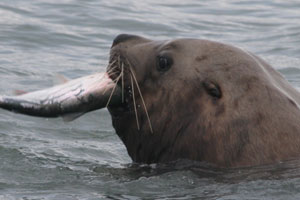Seals and Sea Lions

A male Steller sea lion.
Seals, Sea lions and Walruses are all Pinnipeds. Pinniped means "fin-foot".
Walruses are in their own group, and they live north of the Salish Sea, so we aren't going to talk about them.
Sea lions have an external ear (like that guy in the photo to the right). They can rotate their hind flippers around to point forward when they are out of the water, which means they are pretty good at walking around. Sea lions use their front flippers like wings to propel themselves through the water.
Seals have an internal ear (you can't see it), and they can't rotate their hind flippers. Seals are very awkward out of the water, but they are champion swimmers. They use their whole body to move through the water with a side-to-side motion like a fish.
When to go:
Any time of year!
Where to go:
What to look for:
Seals and sea lions live in salt water but will frequently "haul out" on beaches, rocks, docks and buoys. You can see them from any beach or boat, at any time of the year. Look for pups in the spring and summer.
If you find a pup on the beach, do not approach! Call the Marine Mammal Stranding Network. They will send out a babysitter to watch over the pup.
Mother seals and sea lions leave their pups on the beach to wean them. The pup has not been abandoned. Keep your distance, and if you have a dog be sure to keep it away, too.
-
Harbor Seal
 Harbor seals are the smallest seals in the Salish Sea. They are about 6 feet long. Males and females look alike.
Harbor seals are the smallest seals in the Salish Sea. They are about 6 feet long. Males and females look alike.
Harbor seals are very common, but do not haul out very often. Look for them in the water. Most often you will see a small, round head breaking the surface when they come up to breathe, followed by a glimpse of their back as they dive.
Harbor seals can be very curious about kayakers. When they come up for air they breathe out loudly to clear their nostrils. Listen for the sneeze-like noise if you are out on the water on a still day.
-
Northern Elephant Seal
 Elephant seals are not common in Puget Sound, but become more numerous the closer you get to the open ocean. There is a breeding colony at Race Rocks on Vancouver Island. Females are about 10 feet long, while males are about 18 feet long and can weigh 3 tons!
Elephant seals are not common in Puget Sound, but become more numerous the closer you get to the open ocean. There is a breeding colony at Race Rocks on Vancouver Island. Females are about 10 feet long, while males are about 18 feet long and can weigh 3 tons! Like all true seals, Elephant seals have an internal ear - this is a very useful marker when trying to differentiate between female Elephant seals and Steller sea lions. Male Elephant seals are easy to identify because of their weird noses, and many have scarred shoulders. Both sexes are brown to gray.
-
California Sea Lion
 These charming critters are often trained to star in marine park shows, and many people think of them when seals are mentioned. They are, however, sea lions.
These charming critters are often trained to star in marine park shows, and many people think of them when seals are mentioned. They are, however, sea lions.
California sea lions are quite common in the Salish Sea. Males are 8 feet long and have a stiff crest of fur on their forehead that looks a bit like a buzz-cut. Females are only about 6 feet long and are much slimmer than males. Both sexes are dark brown to black, and their heads have a 'dog-like' look.
Sea lions haul out more frequently than seals, and California sea lions are not shy about using docks and buoys. They can be quite vocal, and will often bark, grunt, squeal and "burp".*
-
Steller Sea Lion
 Steller sea lions look similar to the California sea lion, but are paler in color and are slightly bigger. Males are about 12 feet long and don't have the "buzz-cut" look of the California sea lion. Females are 7 feet long.
Steller sea lions look similar to the California sea lion, but are paler in color and are slightly bigger. Males are about 12 feet long and don't have the "buzz-cut" look of the California sea lion. Females are 7 feet long.
Steller sea lions (also called Steller's sea lions) are endangered, but are beginning to increase in number. They are not very common in the Salish Sea. You will have a better chance of spotting one the further north you go.
Sources:
*Listen to the whole collection of recordings, they are pretty cool: The Cornell Lab of Ornithology Macaulay Library, 2012
PTMSC, 2007
National Audubon Society Guide to Marine Mammals of the World, Knopf 2002
Orca Network, 2012
Images by NOAA
